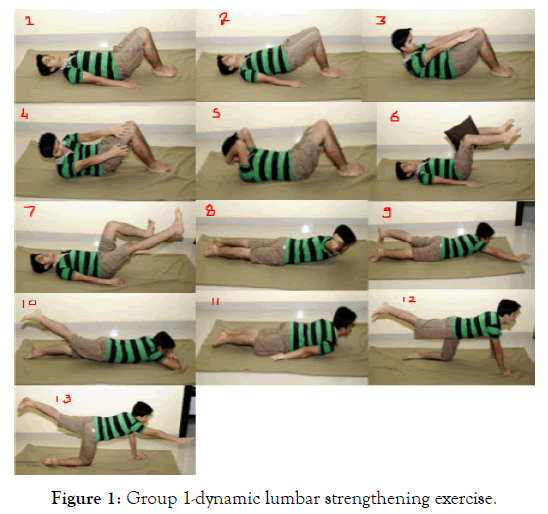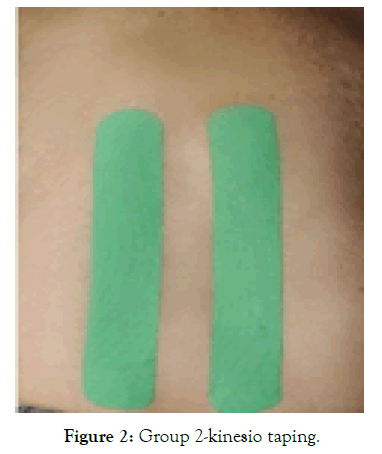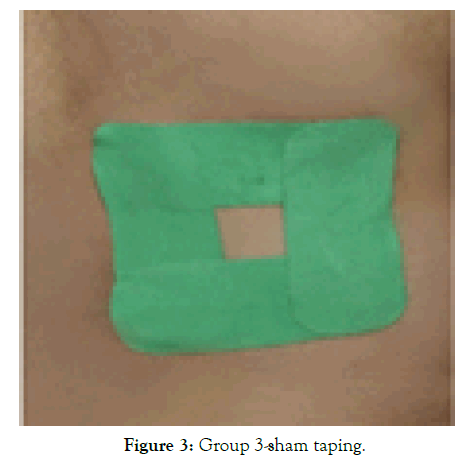Journal of Ergonomics
Open Access
ISSN: 2165-7556
ISSN: 2165-7556
Research Article - (2019)Volume 9, Issue 1
Background: Low back pain leads to loss of work efficiency which could have a negative effect on productivity as well as the quality of life.
Methods: An experimental study was conducted with 60 patients having Non-Specific Low Back Pain (NSLBP) comprising males (43.3%) and females (56.7%) to quantify and ascertain the effective rehabilitative interventions. The patients were randomly selected and equally distributed (n=20) into three groups. Experimental group 1 carried out Dynamic Lumbar Stabilization Exercises (DLSE), Experimental group 2 had Kinesio Taping (KT) and Control group had sham taping. The outcomes were measured by the Numeric Pain Rating Scale, Revised Oswestry Disability Index and Roland Morris Disability Questionnaire.
Results: The results revealed that post interventions both Experimental Group 1 and Experimental Group 2 showed functional improvements; however, a significantly greater improvement in patients of Experimental Group 1 was seen compared to Experimental Group 2. Post interventions, Experimental Group 2 showed significant improvement compared to Control Group.
Conclusion: The study concludes that both DLSE and KT interventions are effective, however, DLSE showed significant attenuation of pain and functional disability in NSLBP. Thus, KT can be used as an adjunct intervention. Future studies may be undertaken to equate the efficacies of other rehabilitative interventions to set priorities or preventive strategies.
Nonspecific low back pain; Dynamic lumbar stabilization exercises; Kinesio taping
Low back disorder elicits back pain affecting over 50% of the general population [1]. It is estimated that over 70% of the adults have at least one episode of low back pain during their life time [2]. Low Back Pain (LBP) is very common and known to be one of the major health problem and an economic burden worldwide [3,4].
Treatment of low back pain has always been, and still is, a challenging field for healthcare practitioners. Treatment is particularly problematic in patients who report significant pain with associated limitations for daily activities, but present with no structural or organic causes. More than 80% of all chronic LBP patients are diagnosed with such Non-Specific Low Back Pain (NSLBP) causing corresponding figures in medical costs [5].
Ergonomists and human factor engineers have identified that flaw movements originates from environmental conditions like repetitive movements at work or sustained postural misalignment reduce postural robustness, inappropriate variability in postural control [6,7]. It impairs sensorimotor control contributing tissue pathology and consequently, lack of spinal cord stability predisposes recurrent LBP [8].
Despite the progress in the understanding of pain and its management, NSLBP is still stated as the leading cause for years lived with disability, worldwide [9]. With the expected increase of this global burden over the next decade, there is an imperative need for effective NSLBP interventions [10]. There are numerous interventions that have been recommended by the European guidelines for the management of low back disorder such as medications [11], exercises [12], health coaching [13], ergonomic education, cognitive behavioral programs [14,15], spinal manipulative therapy [16], chiropractic therapy [17], Kinesio Taping [18], electrotherapy [19] and others. The present study aims to elucidate an essential intervention pertaining to exercises and Kinesio Taping in order to attenuate NSLBP with associated disabilities.
The exercises for this study were selected based on recommendations provided by recent experimental studies [20]. Kim et al. [21] reported that Dynamic Lumbar Strengthening Exercises (DLSE) decrease low back pain disability index of patients as it activates the extensor (erector spinae) and flexor (rectus abdominis) muscle groups [22]. Lumbar strengthening exercises improves lumbar flexibility and abdominal exercises reduce LBP since the pressure on the intervertebral disks decreases as a consequence of increased intra-abdominal pressure during abdominal contraction [23].
A common approach is a low load, high repetition training of the abdominal and trunk muscles for increasing stabilization or muscle imbalance training [24]. These practices were developed in response to evidence indicating specific neuromuscular alterations in the control and activation of the back and abdominal muscles in the presence of back pain conditions [25].
In recent years, the use of Kinesio Tape (KT), a non-invasive therapy worked out by Dr. Kenzo Kase has become increasingly popular [26]. The technique uses a tape which is extremely thin and much more elastic than conventional bandages is applied on the patient’s skin. Such tape can be stretched to 140% of its original length, bringing less mechanical retention and restriction to movement [27]. KT technique produces traction, which generates tension. This traction elevates the epidermis stimulating the mechanoreceptors below the dermis, thus decreasing nociceptive stimuli [28]. KT improves blood and lymphatic circulation, reduces pain, realigns joints, and reduces muscle tension [29]. KT can inhibit excessive activation of the musculature and subsequently improves functionality and reduces pain [30,31].
Since, low back disorder is responsible for substantial work disability and elevated healthcare costs which has become a major global health burden, the researchers of this study aim to compare these interventions in Indian population to enhance and better understand its comparative efficacy in low back disorder.
A total of 60 patients including 26 (43.3%) male and 34 (56.7%) females at the age group between 20 to 50 years (32.45 ± 8.72 years) with a clinical diagnosis of NSLBP, suffering more than three months participated in the study. They were distributed equally and randomly into three groups. An experimental pilot study was conducted in a multispecialty hospital in India which includes a comparison between three groups i.e. Experimental Group 1: Dynamic Lumbar Strengthening Exercises, Experimental Group 2: Kinesio Taping and Control Group 3: Sham Kinesio Taping (control group). The outcomes were measured by using Numeric Pain Rating Scale (NPRS), Revised Oswestry Disability Index (RODI), and Roland Morris Disability Questionnaire (RMDQ).
Numeric pain rating scale
The patient was asked to make three pain ratings, corresponding to current, least and worst pain experienced over the past 24 hours. The average of the three ratings was used to represent the patient’s level of pain over the previous 24 hours [32]. The NPRS has been shown to be a reliable and valid tool by Bolton and Wilkenson [33] which is evaluated on 11 point scale ranging from 0 to 10; where 0 represented no pain and 10 represented the worst pain.
Revised oswestry pain and disability questionnaire
The RODI indicate the extent of a person’s functional level of disability due to back pain. The questionnaire consists of ten sections with six statements. Each section has a rating on a 0-5 point scale each. The points get added together and are converted into a percentage. Oswestry scores are categorized as: minimally disabled (0%-20%), moderately disabled (21%-40%), severely disabled (41%- 60%), crippled (61-80%) and bed bound (81%-100%) [34]. The first section concerns to the level of pain and the remaining sections rate the effect of pain on daily activities such as; sleep, personal care, walking, sitting, standing, lifting, travel, social and sex life [35]. In this study, the patient was asked to mark a statement under each section that best describes the level of disability he/she were experiencing at that particular time.
Roland-morris disability questionnaire
The Roland-Morris Disability Questionnaire is a ‘health status measure’ designed to assess physical disability due to back pain. Participants were asked to tick the check mark beside the statement, if it applies to them on that day. The RMDQ score was calculated by adding up the number of items ticked. The scores of RMDQ ranges from 0 (no disability) to 24 (maximum disability) [36].
Only the patients who attained 10% or more in RODI and scored 4 points or more in RMDQ were taken for this study. NPRS score was also evaluated. The consent was taken from the participants and thereafter the questionnaires and NPRS scores were quantified. The patients were randomly allocated for the rehabilitative interventions in any of the three groups. The intervention was given two times per week for six weeks. The questionnaires and the scores were re-evaluated post-intervention.
Group 1: Dynamic lumbar strengthening exercises
Before each exercise, the researcher gave a detailed verbal explanation and visual instructions regarding the start and end positions. For all exercises in the group, the final static position was held for 10 seconds and each exercise was performed for ten repetitions. There was a pause of 3 seconds between repetitions and a 60-second rest between each exercise. All thirteen exercises (Figure 1) were performed by participants.

Figure 1: Group 1-dynamic lumbar strengthening exercise.
Group 2: Kinesio taping
The tape was positioned on the paravertebral muscles (bilaterally) parallel to the spinous process of the lumbar spine, starting near the posterior superior iliac spine till the level of twelfth thoracic vertebra (T12). The initial anchor point was applied at the sacral region (S1) without tension (0%). After that the participant was asked to flex the trunk and the tape was applied in the shape of “I” over the skin in the paravertebral region up to the extremity of the T12 vertebra at 10-15% tension and the final anchor point was fixed above the T12 with 0% tension. The intervention was followed according to the principles of the technique. To ensure that the adhesive was activated, tape was rubbed manually. The patient was then asked to sit upright and the application was checked for proper adhesion. The patients were instructed to keep the tape for around 3days or till the next session (Figure 2).

Figure 2: Group 2-kinesio taping.
Group 3: Sham taping
Four “I” shape bandages were utilized for the study. A square was made in the lower lumbar region where the pain was maximum. No stretch was applied to the tape in this application. To ensure that the adhesive was activated, tape was rubbed manually (Figure 3).

Figure 3: Group 3-sham taping.
Statistical analysis
As the sample size available in each group was low, so the data was analyzed using non-parametric test. The Mann-Whitney U-test was carried out to identify the differences between NPRS, RODI and RMDQ among patients in Experimental Group 1 vs. control group, Experimental Group 2 vs. control group and between Experimental Group 1 vs. Experimental Group 2. The pre and post-intervention values were compared using the Wilcoxon signed ranks test. The level of significance was set at 0.05.
The independent variables are Experimental group 1, group 2 and the control group. The dependent variables are NPRS, RODI and RMDQ. The linear statistical model can be summarized as:
YNPRS=a+β1 *Experimental Group 1+β2 *Experimental Group 2+β3 *Control Group
YRODI= a+β1 *Experimental Group 1+β2*Experimental Group 2+β3 *Control Group
YRMDQ= a+β1 *Experimental Group 1+β2 *Experimental Group 2+β3 *Control Group
A difference in the distribution of participants according to gender (male/female) among the groups was analyzed using the chi-square test. The values (χ2=1.77, p=0.414) showed no significant difference exists related to gender with the groups (Appendix 1).
A difference in distribution of participants according to age among the groups was analyzed using one way ANOVA. The values (F=0.23, p=0.79) indicated that no significant differences prevailed (Appendix 2).
The result in ; 1 represents the significant improvement experienced by patients post-intervention in Experimental Group 1 and Experimental Group 2 given DLSE and KT interventions respectively. There is no significant difference in the control group (p>0.05).
The comparison in NPRS scores, RODI % and RMDQ scores between Experimental Group 1 and Control Group at pre interventions is insignificant, however there exists a significant difference (p<0.05) between these groups at post interventions (Appendix 3). Similarly, a comparison between Experimental Group 2 and Control Group at pre-interventions shows insignificant, however there exists a significant difference (p<0.05) between these groups at post interventions (Appendix 4). A comparison in scores between Experimental Group 1 and Experimental Group 2 was executed. The result at pre interventions was insignificant, however a significant difference (p<0.05) between these groups at post interventions exists (Appendix 5).
As the low back disorder progresses into a chronic condition, muscle strength, endurance, and flexibility of the trunk are reduced, limiting one’s range of motion [37]. As a result, low back pain patient’s level of participation in everyday and social activities decrease, and their quality of life deteriorates [38,39]. So this study was conducted with a purpose to elucidate and compare the effective rehabilitative interventions for NSLBP.
Table 1 showed that DLSE and KT both were effective in Experimental Group 1 and Experimental Group 2, respectively in attenuating functional disability which occurred due to pain. In accordance, literature shows that both DLSE and KT interventions enhance functional improvement in patients with disability [21,31].
Table 1: Comparison between Pre and Post–interventions with NPRS, RODI and RMDQ scores among Groups
| Group | Parameter | Pre-interventions | Post-interventions | p-value |
|---|---|---|---|---|
| Mean ± SD | Mean ± SD | |||
| Exp. Group 1 | NPRS (Score) | 8.70 ± 0.87 | 2.25 ± 1.16 | 0.000* |
| RODI (%) | 44.97 ± 8.80 | 8.32 ± 5.14 | 0.000* | |
| RMDQ (Score) | 13.05 ± 2.06 | 3.25 ± 1.29 | 0.000* | |
| Exp. Group 2 | NPRS (Score) | 8.55 ± 0.89 | 3.85 ± 1.23 | 0.000* |
| RODI (%) | 46.86 ± 5.53 | 23.96 ± 8.27 | 0.000* | |
| RMDQ (Score) | 12.95 ± 2.11 | 5.35 ± 1.14 | 0.000* | |
| Control Group | NPRS (Score) | 8.65 ± 0.88 | 8.65 ± 0.88 | 1.00 |
| RODI (%) | 44.64 ± 6.47 | 44.64 ± 6.47 | 1.00 | |
| RMDQ (Score) | 13.15 ± 2.11 | 13.15 ± 2.11 | 1.00 |
*Significance at the level of p<0.05.
A significantly greater improvement in patients of Experimental Group 1 was seen compared to patients in Experimental Group 2, shown in Appendix 5. Therefore; the results of the study indicate DLSE is more effective in improving dysfunctional ability and associated pain in patients suffering from the low back disorder. This can be justified by scientific evidence which suggest that active rehabilitation involving exercise is most effective in reducing disability and LBP recurrence [40]. Ha [41] observed that lumbar strengthening exercises performed by chronic low back pain patient’s greatly improved lumbar flexibility. Rodacki et al., [23] suggested that abdominal exercises reduce LBP since the pressure on the intervertebral disks decreases as a consequence of increased intra-abdominal pressure during abdominal contraction. DSLE activates both abdominal and para-spinal muscles, attenuating NSLBP.
As shown in Appendix 4, Experimental Group 2 showed significant improvement at post interventions compared to Control Group. Our findings, is also in accordance with the observations made by Kim CH et al., [42] who specified in his study that KT was more efficacious than placebo in patients with NSLBP.
The study can be repeated with higher sample size and well as applying Kinesio Taping to the participants who also performed DLSE in future studies.
The study revealed that both DLSE and KT interventions are effective in NSLBP however DLSE showed significant attenuation of pain and functional disability. Thus, KT can be used as an adjunct intervention. The present study suggests ergonomists and healthcare practitioners that while designing rehabilitative interventions for NSLBP, exercise must be considered as an essential intervention.
The study was self-funded; however, authors would like to gratefully acknowledge the support of the hospital involved in the study. We would also like to thank all the patients who participated in the project. A special thanks to the editorial team of this journal for their support.
Citation: Das SK, Mathur A, Babu H (2019) Efficacy of Rehabilitative Interventions to Attenuate Nonspecific Low Back Pain–A Pilot Study. J Ergonomics 9:248.
Received: 20-May-2019 Accepted: 24-Jun-2019 Published: 01-Jul-2019 , DOI: 10.35248/2165-7556.19.9.248
Copyright: © 2019 Das SK, et al. This is an open-access article distributed under the terms of the Creative Commons Attribution License, which permits unrestricted use, distribution, and reproduction in any medium, provided the original author and source are credited.